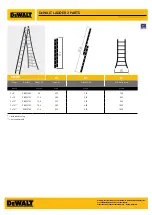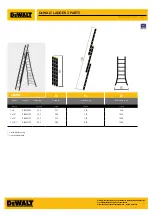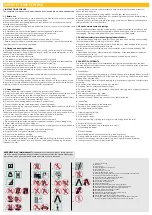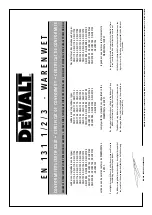
INSTRUCTIONS FOR USE
1 INSTRUCTIONS FOR USE
The complete user manual can be downloaded from the website www.dewaltladders.be
1.1 Before use
a
. Ensure you are sufficiently fit to use a ladder. Certain medical conditions or medication,
alcohol and drug use can make it unsafe to use a ladder;
b
. Ensure that when transporting ladders on roof racks or in a truck, they are properly
secured to avoid any damage;
c
. Inspect the ladder following delivery and before first use, to ensure that all components
are working correctly;
d
. Before each job, check that the ladder is not damaged and is safe to use;
e
. Professional users must ensure the ladder is regularly inspected;
f
. Check that the ladder is suitable for the specific job;
g
. Never use a damaged ladder;
h
. Remove all dirt from the ladder, such as wet paint, mud, oil or snow;
i
. Before using the ladder, a risk assessment must be carried out in accordance with the
legal provisions of the country concerned.
1.2 Placing and erecting the ladder
a
. Stand the ladder in the correct position, that is, using the correct angle for a leaning
ladder (approximately 1:4 angle) with the rungs or steps in a horizontal position, or fully
opened if it is a free-standing ladder;
b
. Use the ladder’s locking mechanism;
c
. The ladder must be placed on level, horizontal and firm ground;
d
. The leaning ladder must be placed against an even, firm surface and secured before
use, by tying it or by using a suitable stand-off device for stability;
e
. Never move the ladder from the top;
f
. When placing the ladder, anticipate the risk of impact, for example from pedestrians,
vehicles or doors. Where possible, close all doors (with the exception of emergency exits)
and windows in the work area;
g
. Consider possible electrical hazards in the work area, such as power lines and other
exposed electrical equipment;
h
. The ladder must rest on its foot pads, not on the rungs or steps;
i
. Ladders must never be placed on slippery surfaces (such as ice, shiny surfaces, or very
dirty surfaces), unless additional effective measures are taken to prevent the ladder from
slipping, or unless dirty surfaces have been sufficiently cleaned.
1.3 Using the ladder
a
. Never exceed the total maximum load for a particular type of ladder;
b
. Do not overreach when working on a ladder, the user must take care that the belt buck-
le (navel) remains within the rails and that both feet are on the same rung/step;
c
. Do not step from a leaning ladder on to a higher level without taking additional safety
precautions, such as a rope or a suitable stability device;
d
. Do not use free-standing ladders for access to another level;
e
. Do not stand on the top three rungs/steps of a leaning ladder;
f
. Never stand on the top two rungs/steps of a free-standing ladder, without a platform or
a hand and knee rail;
g
. Do not climb higher than the hinge point / hook of the A-position of a free-standing
ladder with an extension ladder at the top. The third part can only be extended for maxi-
mum 1 meter when the ladder is used as free-standing ladder in A-position;
h
. Ladders must only be used for light work of short duration;
i
. Use a non-conductive ladder for unavoidable live electrical work;
j
. Do not use the ladder outdoors in adverse weather conditions, such as strong wind;
k
. Never allow children to play on a ladder;
l
. Where possible, close all doors (with the exception of emergency exits) and windows in
the work area;
m
. Always face the ladder rungs while climbing or descending;
n
. Grip the ladder firmly when climbing or descending;
o
. Do not use the ladder as a bridge;
p
. Wear suitable footwear when climbing a ladder;
q
. Avoid excessive lateral load caused by, for example, drilling into brick and concrete;
r
. Do not remain on a ladder for a long period of time without taking a regular break
(tiredness is a risk);
s
. Leaning ladders that are used for access to a higher level must protrude at least 1 m
above the landing point;
t
. Any materials carried while using a ladder must be light and easy to handle;
u
. Avoid work that causes a lateral load on free-standing ladders, such as lateral drilling in
hard material (e.g. brick or concrete);
v
. Ensure you have sufficient grip while carrying out work on the ladder or take adequate
safety measures if this is not possible.
1.4 Repairs, maintenance and storage
Repairs and maintenance must be carried out by a competent person in accordance with
the manufacturer’s instructions. Store portable ladders and steps in such a way as to pre-
vent sagging. Store portable ladders and steps in a cool ventilated space.
1.5 Additional safety tips when using step ladders/ladders
• Do not wear baggy clothing or jewellery. These may snag when climbing or descending
the step ladder or ladder, resulting in the risk of falling.
• Regularly check that the feet are not worn. Worn feet can cause damage to the ground,
or may cause the step ladder or ladder to slip.
• In the interest of personal safety, only use accessories or tools recommended by DAS
Ladders.
• Never place any tools or other materials at the bottom of the step ladder or ladder as
they can cause you to trip.
• A ladder weighing more than 25 kg must always be carried by two people.
2 CAUSES OF ACCIDENTS
The following (incomplete) list of hazards and their possible causes identifies the most
common reasons for accidents when using ladders. This forms the basis of the information
contained in these guidelines.
a. Stability loss:
1
. Incorrect positioning of the ladder (e.g. the incorrect angle for a leaning ladder or not ful-
ly opening a free-standing ladder);
2
. Slipping on the ground (e.g. the bottom of the ladder
slipping away from the wall);
3
. Lateral slipping, lateral falling and toppling (e.g. by overreaching or bad contact surface
at the top);
4
. Condition of the ladder (e.g. missing non-slip feet)
5
. Stepping from an unsecured ladder at height;
6
. Condition of the ground (e.g. unstable, soft ground, sloping ground, slippery surfaces or
dirty, hard surfaces);
7
. Bad weather conditions (e.g. wind);
8
. Impact to ladder (e.g. vehicle or door);
9
. Incorrect choice of ladder (e.g. too short, unsuitable for the job).
b. In handling:
1
. Transporting the ladder to the workplace;
2
. Setting up and dismantling the ladder;
3
. Carrying objects on the ladder.
c. Slipping, tripping, falling:
1
. Incorrect footwear;
2
. Dirty rungs or steps;
3
. Unsafe actions (e.g. climbing two rungs at a time, sliding down the rails).
d. Structural faults to the ladder:
1
. Condition of the ladder (e.g. damaged rails, wear);
2
. Overloading the ladder.
e. Electrical hazards:
1
. Unavoidable work in live environment (e.g. repairing faults);
2
. Placing ladders too close to live electrical equipment (e.g. power lines);
3
. Ladders that damage electrical material (e.g. housing or protective insulation);
4
. Incorrect choice of ladder for electrical work.
APPENDIX A: A1 Informational:
This appendix contains examples of safety signs for
the basic manual supplied with each ladder. In these examples, the square safety signs
(sometimes with a green border) denote a positive action to be taken.
max.
150 kg
MAX. 150 kg
4x
1x
OIL
H O
2
MIN.
1 m
1 m
MAX. 1
1.
2.
3.
4.
5.
6.
7.
8.
9.
10.
11.
12.
13.
14.
15.
16.
17.
18.
19.
20.
21.
22.
23.
1
: Read the instructions
2
: Peak load
3
: Correct angle
4
: Place the ladder on a level ground
5
: Do not overreach
6
: Ensure the ground is clean
7
: Place the ladder on firm ground
8
: Ladder length extension above the point at which the ladder provides access
9
: Do not step off the ladder from the side
10
: Only one person per climbable part of the ladder
11
: Carry out a visual inspection before use
12
: Do not use the ladder as a bridge
13
: Do not stand on the top rung
14
: Inspect the ladder’s feet
15
: Be aware of electrical hazards when moving the ladder
16
: Face the ladder rungs while climbing or descending the ladder
17
: Ensure that a free-standing ladder is fully open before use
18
: Maximum number of personson the ladder
19
: Secure top/bottom of the ladder
20
: Ensure the top of the ladder has been placed correctly
21
: Ensure the spreader lock is engaged
22
: Use the ladder with the correct end facing upwards
23
: Do not climb higher than the hinge point / hook of the ladder in A-position.
Third part of ladder can be extended for max.1 meter in A-position..


















